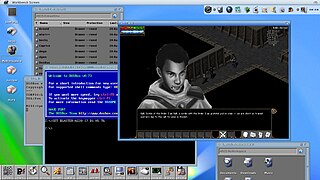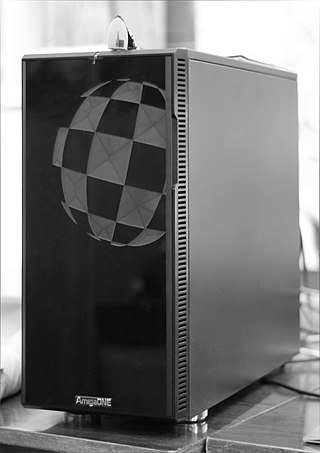
Amiga is a family of personal computers introduced by Commodore in 1985. The original model is one of a number of mid-1980s computers with 16- or 16/32-bit processors, 256 KB or more of RAM, mouse-based GUIs, and significantly improved graphics and audio compared to previous 8-bit systems. These systems include the Atari ST—released earlier the same year—as well as the Macintosh and Acorn Archimedes. Based on the Motorola 68000 microprocessor, the Amiga differs from its contemporaries through the inclusion of custom hardware to accelerate graphics and sound, including sprites and a blitter, and a pre-emptive multitasking operating system called AmigaOS.
AmigaDOS is the disk operating system of the AmigaOS, which includes file systems, file and directory manipulation, the command-line interface, and file redirection.
AmigaOne is a series of computers intended to run AmigaOS 4 developed by Hyperion Entertainment, as a successor to the Amiga series by Commodore International. Earlier models were produced by Eyetech, and were based on the Teron series of PowerPC POP mainboards. In September 2009, Hyperion Entertainment secured an exclusive licence for the AmigaOne name and subsequently new AmigaOne computers were released by A-Eon Technology and Acube Systems.
MorphOS is an AmigaOS-like computer operating system (OS). It is a mixed proprietary and open source OS produced for the Pegasos PowerPC (PPC) processor based computer, PowerUP accelerator equipped Amiga computers, and a series of Freescale development boards that use the Genesi firmware, including the Efika and mobileGT. Since MorphOS 2.4, Apple's Mac mini G4 is supported as well, and with the release of MorphOS 2.5 and MorphOS 2.6 the eMac and Power Mac G4 models are respectively supported. The release of MorphOS 3.2 added limited support for Power Mac G5. The core, based on the Quark microkernel, is proprietary, although several libraries and other parts are open source, such as the Ambient desktop.

Hyperion Entertainment CVBA is a Belgian software company which in its early years focused in porting Windows games to Amiga OS, Linux, and Mac OS. In 2001, they accepted a contract by Amiga Incorporated to develop AmigaOS 4 and mainly discontinued their porting business to pursue this development. AmigaOS 4 runs on the AmigaOne systems, Commodore Amiga systems with a Phase5 PowerUP accelerator board, Pegasos II systems and Sam440/Sam460 systems.
The Amiga Fast File System is a file system used on the Amiga personal computer. The previous Amiga filesystem was never given a specific name and known originally simply as "DOS" or AmigaDOS. Upon the release of FFS, the original filesystem became known as Amiga Old File System (OFS). OFS, which was primarily designed for use with floppy disks, had been proving slow to keep up with hard drives of the era. FFS was designed as a full replacement for the original Amiga filesystem. FFS differs from its predecessor mainly in the removal of redundant information. Data blocks contain nothing but data, allowing the filesystem to manage the transfer of large chunks of data directly from the host adapter to the final destination.
The Smart File System (SFS) is a journaling filesystem used on Amiga computers and AmigaOS-derived operating systems. It is designed for performance, scalability and integrity, offering improvements over standard Amiga filesystems as well as some special or unique features.
Amiga, Inc. is a company that used to hold some trademarks and other assets associated with the Amiga personal computer.
AmigaOS is the proprietary native operating system of the Amiga personal computer. Since its introduction with the launch of the Amiga 1000 in 1985, there have been four major versions and several minor revisions of the operating system.

Workbench is the desktop environment and graphical file manager of AmigaOS developed by Commodore International for their Amiga line of computers. Workbench provides the user with a graphical interface to work with file systems and launch applications. It uses a workbench metaphor for representing file system organisation.

AROS Research Operating System is a free and open-source multi media centric implementation of the AmigaOS 3.1 application programming interface (API). Designed to be portable and flexible. As of 2021, ports are available for personal computers (PCs) based on x86 and PowerPC, in native and hosted flavors, with other architectures in development. In a show of full circle development, AROS has been ported to the Motorola 68000 series (m68k) based Amiga 1200, and there is also an ARM port for the Raspberry Pi series.
Amiga support and maintenance software performs service functions such as formatting media for a specific filesystem, diagnosing failures that occur on formatted media, data recovery after media failure, and installation of new software for the Amiga family of personal computers—as opposed to application software, which performs business, education, and recreation functions.

AmigaOS is a family of proprietary native operating systems of the Amiga and AmigaOne personal computers. It was developed first by Commodore International and introduced with the launch of the first Amiga, the Amiga 1000, in 1985. Early versions of AmigaOS required the Motorola 68000 series of 16-bit and 32-bit microprocessors. Later versions were developed by Haage & Partner and then Hyperion Entertainment. A PowerPC microprocessor is required for the most recent release, AmigaOS 4.

Sam440, also known by Sam or its codename Samantha, is a line of modular motherboards produced by the Italian company ACube Systems Srl. The Sam440ep version is a motherboard based on the PowerPC 440EP system-on-a-chip processor which includes a double-precision FPU. It is made by AMCC. Their primary targets are the industrial and embedded markets, running operating systems such as Linux and AmigaOS 4.
ACube Systems Srl is a company that started in January 2007 from the synergy of the Italian companies Alternative Holding Group Srl, Soft3 and Virtual Works.
The following history of the AmigaOS 4 dispute documents the legal battle mainly between the companies Amiga, Inc. and Hyperion Entertainment over the operating system AmigaOS 4. On 30 September 2009, Hyperion and Amiga, Inc. reached a settlement agreement where Hyperion was granted an exclusive, perpetual and worldwide right to distribute and use 'The Software', a term used during the dispute and subsequent settlement to refer to source code from AmigaOS 3 and earlier, and ownership of AmigaOS 4.x and beyond.

AmigaOne X1000 is a PowerPC-based personal computer intended as a high-end platform for AmigaOS 4. It was announced by A-Eon Technology CVBA in partnership with Hyperion Entertainment and released in 2011. Its name pays homage to the Amiga 1000 released by Commodore in 1985. It is, however, not hardware-compatible with the original Commodore Amiga system.
Warp3D was a project founded by Haage & Partner in 1998 that aimed to provide a standard API that would enable programmers to access, and therefore use, 3D hardware on the Amiga.

Commodore USA, LLC was a computer company based in Pompano Beach, Florida, with additional facilities in Fort Lauderdale, Florida. Commodore USA, LLC was founded in April 2010. The company's goal was to sell a new line of PCs using the classic Commodore and Amiga name brands of personal computers, having licensed the Commodore brand from Commodore Licensing BV on August 25, 2010 and the Amiga brand from Amiga, Inc. on August 31, 2010.

A new version of AmigaOS was released on December 24, 2006 after five years of development by Hyperion Entertainment (Belgium) under license from Amiga, Inc. for AmigaOne registered users.














